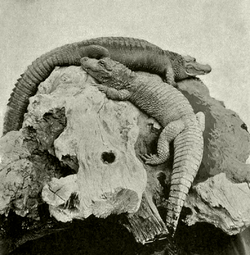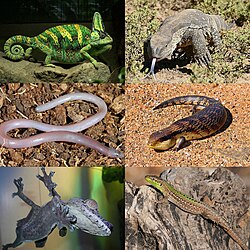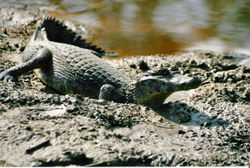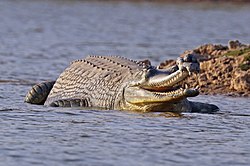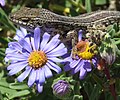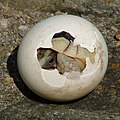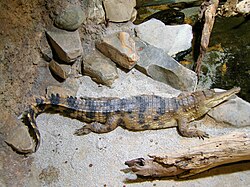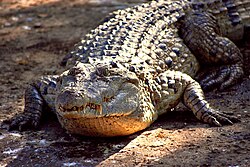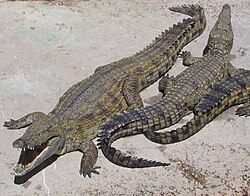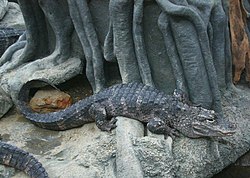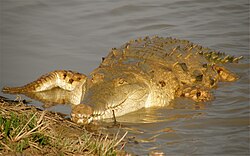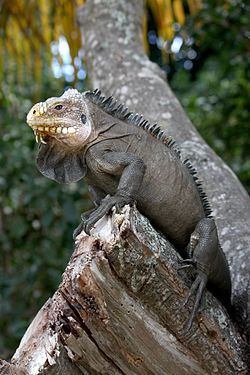Portal:Reptiles
Portal maintenance status: (June 2018)
|
The Reptiles Portal
Reptiles, as commonly defined, are a group of tetrapods with an ectothermic metabolism and amniotic development. Living traditional reptiles comprise four orders: Testudines, Crocodilia, Squamata, and Rhynchocephalia. About 12,000 living species of reptiles are listed in the Reptile Database. The study of the traditional reptile orders, customarily in combination with the study of modern amphibians, is called herpetology.
Reptiles have been subject to several conflicting taxonomic definitions. In Linnaean taxonomy, reptiles are gathered together under the class Reptilia (/rɛpˈtɪliə/ rep-TIL-ee-ə), which corresponds to common usage. Modern cladistic taxonomy regards that group as paraphyletic, since genetic and paleontological evidence has determined that birds (class Aves), as members of Dinosauria, are more closely related to living crocodilians than to other reptiles, and are thus nested among reptiles from an evolutionary perspective. Many cladistic systems therefore redefine Reptilia as a clade (monophyletic group) including birds, though the precise definition of this clade varies between authors. Others prioritize the clade Sauropsida, which typically refers to all amniotes more closely related to modern reptiles than to mammals.
The earliest known proto-reptiles originated from the Carboniferous period, having evolved from advanced reptiliomorph tetrapods which became increasingly adapted to life on dry land. The earliest known eureptile ("true reptile") was Hylonomus, a small and superficially lizard-like animal which lived in Nova Scotia during the Bashkirian age of the Late Carboniferous, around 318 million years ago. Genetic and fossil data argues that the two largest lineages of reptiles, Archosauromorpha (crocodilians, birds, and kin) and Lepidosauromorpha (lizards, and kin), diverged during the Permian period. In addition to the living reptiles, there are many diverse groups that are now extinct, in some cases due to mass extinction events. In particular, the Cretaceous–Paleogene extinction event wiped out the pterosaurs, plesiosaurs, and all non-avian dinosaurs alongside many species of crocodyliforms and squamates (e.g., mosasaurs). Modern non-bird reptiles inhabit all the continents except Antarctica. (Full article...)
Reptile types
-
Image 11905 photograph of an American alligator (top) and a Chinese alligator
An alligator, or colloquially gator, is a large reptile in the genus Alligator of the family Alligatoridae in the order Crocodilia. The two extant species are the American alligator (A. mississippiensis) and the Chinese alligator (A. sinensis). Additionally, several extinct species of alligator are known from fossil remains. Alligators first appeared during the late Eocene epoch about 37 million years ago. (Full article...) -
Image 2
Turtles are reptiles of the order Testudines, characterized by a special shell developed mainly from their ribs. Modern turtles are divided into two major groups, the Pleurodira (side necked turtles) and Cryptodira (hidden necked turtles), which differ in the way the head retracts. There are 360 living and recently extinct species of turtles, including land-dwelling tortoises and freshwater terrapins. They are found on most continents, some islands and, in the case of sea turtles, much of the ocean. Like other amniotes (reptiles, birds, and mammals) they breathe air and do not lay eggs underwater, although many species live in or around water. (Full article...) -
Image 3
The tuatara (Sphenodon punctatus) is a species of reptile endemic to New Zealand. Despite its close resemblance to lizards, it is actually the only extant member of a distinct lineage, the previously highly diverse order Rhynchocephalia. The name tuatara is derived from the Māori language and means "peaks on the back". (Full article...) -
Image 4Clockwise from top left: veiled chameleon (Chamaeleo calyptratus), rock monitor (Varanus albigularis), common blue-tongued skink (Tiliqua scincoides), Italian wall lizard (Podarcis sicula), giant leaf-tailed gecko (Uroplatus fimbriatus), and legless lizard (Anelytropsis papillosus)
Lizard is the common name used for all squamate reptiles other than snakes (and to a lesser extent amphisbaenians), encompassing over 7,000 species, ranging across all continents except Antarctica, as well as most oceanic island chains. The grouping is paraphyletic as some lizards are more closely related to snakes than they are to other lizards. Lizards range in size from chameleons and geckos a few centimeters long to the 3-meter-long Komodo dragon. (Full article...) -
Image 5
Snakes are elongated limbless reptiles of the suborder Serpentes (/sɜːrˈpɛntiːz/). Cladistically squamates, snakes are ectothermic, amniote vertebrates covered in overlapping scales much like other members of the group. Many species of snakes have skulls with several more joints than their lizard ancestors and relatives, enabling them to swallow prey much larger than their heads (cranial kinesis). To accommodate their narrow bodies, snakes' paired organs (such as kidneys) appear one in front of the other instead of side by side, and most only have one functional lung. Some species retain a pelvic girdle with a pair of vestigial claws on either side of the cloaca. Lizards have independently evolved elongate bodies without limbs or with greatly reduced limbs at least twenty-five times via convergent evolution, leading to many lineages of legless lizards. These resemble snakes, but several common groups of legless lizards have eyelids and external ears, which snakes lack, although this rule is not universal (see Amphisbaenia, Dibamidae, and Pygopodidae). (Full article...) -
Image 6Nile crocodile (Crocodylus niloticus)
Crocodiles (family Crocodylidae) or true crocodiles are large, semiaquatic reptiles that live throughout the tropics in Africa, Asia, the Americas and Australia. The term "crocodile" is sometimes used more loosely to include all extant members of the order Crocodilia, which includes the alligators and caimans (both members of the family Alligatoridae), the gharial and false gharial (both members of the family Gavialidae) as well as other extinct taxa. (Full article...) -
Image 7Blanus cinereus, Spain
Amphisbaenia /æmfɪsˈbiːniə/ (called amphisbaenians or worm lizards) is a group of typically legless lizards, comprising over 200 extant species. Amphisbaenians are characterized by their long bodies, the reduction or loss of the limbs, and rudimentary eyes. As many species have a pink body and scales arranged in rings, they have a superficial resemblance to earthworms. While the genus Bipes retains forelimbs, all other genera are limbless. Phylogenetic studies suggest that they are nested within Lacertoidea, closely related to the lizard family Lacertidae. Amphisbaenians are widely distributed, occurring in North America, Europe, Africa, South America, Western Asia and the Caribbean. Most species are less than 6 inches (15 cm) long. (Full article...) -
Image 8Yacare caiman, Caiman yacare
A caiman (/ˈkeɪmən/ (also spelled cayman) from Taíno kaiman[additional citation(s) needed]) is an alligatorid belonging to the subfamily Caimaninae, one of two primary lineages within the Alligatoridae family, the other being alligators. Caimans are native to Central and South America and inhabit marshes, swamps, lakes, and mangrove rivers. They have scaly skin and live a fairly nocturnal existence. They are relatively small-sized crocodilians with an average maximum weight of 6 to 40 kg (13 to 88 lb) depending on species, with the exception of the black caiman (Melanosuchus niger), which can grow more than 4 m (13 ft) long and weigh more than 450 kg (990 lb). The black caiman is the largest caiman species in the world and is found in the slow-moving rivers and lakes that surround the Amazon basin. The smallest species is the Cuvier's dwarf caiman (Paleosuchus palpebrosus), which grows to 1.2 to 1.5 m (3.9 to 4.9 ft) long. There are six different species of caiman found throughout the watery jungle habitats of Central and Southern America. The average length for most of the other caiman species is about 2 to 2.5 m (6.6 to 8.2 ft) long. (Full article...) -
Image 9
The gharial (Gavialis gangeticus), also known as gavial or fish-eating crocodile, is a crocodilian in the family Gavialidae and among the longest of all living crocodilians. Mature females are 2.6 to 4.5 m (8 ft 6 in to 14 ft 9 in) long, and males 3 to 6 m (9 ft 10 in to 19 ft 8 in). Adult males have a distinct boss at the end of the snout, which resembles an earthenware pot known as a ghara, hence the name "gharial". The gharial is well adapted to catching fish because of its long, narrow snout and 110 sharp, interlocking teeth. (Full article...) -
Image 10Aldabra giant tortoise
(Aldabrachelys gigantea)
Tortoises (/ˈtɔːrtəs.ɪz/ TOR-təs-iz) are reptiles of the family Testudinidae of the order Testudines (Latin for "tortoise"). Like other turtles, tortoises have a shell to protect from predation and other threats. The shell in tortoises is generally hard, and like other members of the suborder Cryptodira, they retract their necks and heads directly backward into the shell to protect them. (Full article...)
Selected images
-
Image 1Photo credit: Mila ZinkovaThe green turtle (Chelonia mydas) is a large sea turtle belonging to the family Cheloniidae. Despite the turtle's common name, it is lightly-colored all around while its carapace's hues range from olive-brown to black. The turtle is actually named for the greenish coloration of its fat and flesh.
-
Image 2Photo: Muhammad Mahdi KarimTwo Trachylepis maculilabris skinks mating. Skinks are lizards that generally have no pronounced neck and relatively small legs. Females may be egg-laying or give live birth, with many of the latter being ovoviviparous (hatching eggs internally and giving birth to live offspring).
-
Image 3Photograph: Charles J. SharpA rough chameleon (Trioceros rudis) near Mount Karisimbi, an inactive volcano in the Virunga Mountains in Rwanda. This specimen measures approximately 12 cm (4.7 in) long. Chameleons change color by changing the space between crystals in their skin, which changes the wavelength of light they reflect.
-
Image 5Cape skink – Trachylepis capensis. Close-up on purple Aster flowers.
-
Image 6Asian vine snake Ahaetulla prasina. This snake has a wide distribution in Asia. It feeds on small reptiles and amphibians, particularly lizards and tree frogs. Adults may attain 1.8 m (6 feet) in total length, with a tail 0.6 m (2 feet) long. Its appearance is very much like those of South American vine snakes. It is a rear-fanged species and is mildly venomous but is not considered a threat to humans.
-
Image 7Photo credit: Paul HirstAn anole lizard of the family Polychrotidae found in Hilo, Hawaii, United States. Anoles are small and common lizards that can be found throughout the various regions of the Western Hemisphere. They are frequently and incorrectly called chameleons or geckos due to their ability to alter their skin color and run up walls, respectively.
-
Image 8Photograph: Benny TrappThe Sicilian wall lizard (Podarcis waglerianus) is a species of lizard in the family Lacertidae. Endemic to Italy, it occurs in temperate forests, temperate shrubland, Mediterranean-type shrubby vegetation, temperate grassland, arable land, pastureland, and rural gardens in Sicily and the Aegadian Islands. The species' numbers are generally stable, and it has been listed as Least Concern by the IUCN.
-
Image 9Photograph: Ministry of Information and Tourism of EcuadorA Julia butterfly (Dryas iulia) feeding on the tears of a red-headed Amazon River turtle (Podocnemis erythrocephala) in Ecuador. Such lachryphagy provides the butterfly with additional minerals that it can use for spermatophore production.
-
Image 10Photo credit: John O'NeillA common snakeneck turtle (Chelodina longicollis) covered in camouflaging algae. When resting this individual would look like an algae-covered rock, an example of crypsis, the ability of an organism to avoid observation. Other ways an organism may be cryptic include nocturnality, subterranean lifestyle, and transparency.
-
Image 12Photo credit: Marcel Burkhard (cele4)The Plumed Basilisk (Basiliscus plumifrons) is a species of lizard native to Latin America. Its natural range covers a swath from Mexico to Ecuador.
-
Image 13The Aldabra Giant Tortoise (Geochelone gigantea), from the islands of the Aldabra Atoll in the Seychelles, is one of the largest tortoises in the world. Similar in size to the famous Galapagos Giant Tortoise, its carapace averages 120 centimetres (47 in) in length. The average weight is around 250 kilograms (550 lb) for males and 150 kilograms (330 lb) for females.
-
Image 15Photograph: M. ArunprasadThe Indian chameleon (Chamaeleo zeylanicus) is a species of chameleon found in Sri Lanka, India, and other parts of South Asia. Like other chameleons, this species has a long tongue, feet that are shaped into bifid claspers, a prehensile tail, independent eye movement, and the ability to change skin colour. They move slowly with a bobbing or swaying movement and are usually arboreal. They are usually in shades of green or brown or with bands, but can change colour rapidly.
-
Image 16Photograph: Geoff GalliceBothriechis schlegelii is a venomous pit viper species found in Central and South America. Small and arboreal, these snakes are characterized by their wide array of color variations, as well as the superciliary scales over the eyes. They are the most common of the palm-pitvipers and are often present in zoological exhibits. The specific name schlegelii honors the German ornithologist, Hermann Schlegel. No subspecies are currently recognized.
-
Image 17The common collared lizard (Crotaphytus collaris) is a North American lizard well known for its ability to run on its hind legs. Its length, including the tail, can reach up to 12 inches (30 cm). Its name reflects its distinct coloration, which includes bands of black around the neck and shoulders that resemble a collar.
-
Image 18A baby marginated tortoise hatchling emerges from its shell.
-
Image 19Photograph credit: Charles James SharpParson's chameleon (Calumma parsonii) is a large species of chameleon, a lizard in the family Chamaeleonidae. The species is endemic to isolated pockets of humid primary forest in eastern and northern Madagascar. It is listed on CITES Appendix II, meaning that trade in this species is regulated. While it is illegal for most chameleon species from Madagascar to be exported, a limited number of Parson's chameleons can legally be exported each year from its native country. This female Parson's chameleon of the subspecies C. p. cristifer was photographed near Andasibe, Moramanga.
-
Image 20Cerastes cerastes, commonly known as the Saharan horned viper or the horned desert viper, is a venomous species of viper native to the deserts of northern Africa and parts of the Arabian Peninsula and Levant. It often is easily recognized by the presence of a pair of supraocular "horns", although hornless individuals do occur.
-
Image 22Photo credit: PollinatorThe Carolina Anole is a lizard found primarily in the south eastern parts of the United States. It has color-changing abilities, although it is not a chameleon. This lizard can reach a total length of about 22 cm. The male has a pink or red dewlap that extends from his chin. Green Anoles can have a green or a brown body colour, which depends on mood and climate.
-
Image 23Photo credit: Jon ZanderThe Florida Box Turtle (Terrapene carolina bauri) is endemic to the U.S. state of Florida and the extreme southeastern portion of Georgia. It can be found in damp environments, such as wetlands, marshlands, and near swamps, but usually does not enter water deep enough to swim.
-
Image 24The American five-lined skink (Eumeces fasciatus) is one of the most common lizards in the eastern United States, as well as one of the five lizard species extant in Canada. It is a small to medium sized skink growing to about 12.5 to 21.5 cm (4.9 to 8.5 in). Juveniles (as seen here) are dark brown to black with five distinctive white to yellowish stripes running along the body and a bright blue tail.
-
Image 25Photograph: Charles J. SharpThe yacare caiman (Caiman yacare) is a species of caiman found in central South America. About ten million individuals, such as this one, exist within the Brazilian pantanal, representing what may be the largest single crocodilian population on Earth. This small-to-medium sized species feeds mainly on fish (especially piranha), but also eats birds, reptiles, and small mammals.
Selected Crocodilia articles
-
Image 1
Mecistops is a genus of crocodiles, the slender-snouted crocodiles, native to sub-Saharan Africa. (Full article...) -
Image 2
The spectacled caiman (Caiman crocodilus), also known as the white caiman, common caiman, and speckled caiman, is a crocodilian in the family Alligatoridae. It is brownish-, greenish-, or yellowish-gray colored and has a spectacle-like ridge between its eyes, which is where its common name come from. It grows to a length of 1.4–2.5 m (4 ft 7 in – 8 ft 2 in) and a weight of 7–40 kg (15–88 lb), with males being both longer and heavier than females. Its diet varies seasonally, commonly consisting of crabs, fish, small mammals, amphibians and snails. Breeding occurs from May to August and 14–40 eggs are laid in July and August. This crocodilian has a large range and population; it is native to much of Latin America, and has been introduced to the United States, Cuba, and Puerto Rico. (Full article...) -
Image 3
The Siamese crocodile (Crocodylus siamensis) is a medium-sized freshwater crocodile native to Indonesia (Borneo and possibly Java), Brunei, East Malaysia, Laos, Cambodia, Myanmar, Thailand and Vietnam. The species is critically endangered and already extirpated from many regions. Its other common names include Siamese freshwater crocodile, Singapore small-grain, and soft-belly. (Full article...) -
Image 4

Cuvier's dwarf caiman (Paleosuchus palpebrosus) is a small crocodilian in the alligator family from northern and central South America. It is found in Bolivia, Brazil, Colombia, Ecuador, French Guiana, Guyana, Paraguay, Peru, Suriname, Trinidad and Venezuela. It lives in riverine forests, flooded forests near lakes, and near fast-flowing rivers and streams. It can traverse dry land to reach temporary pools and tolerates colder water than other species of caimans. Other common names for this species include the musky caiman, the dwarf caiman, Cuvier's caiman, and the smooth-fronted caiman (the latter name is also used for P. trigonatus). It is sometimes kept in captivity as a pet and may be referred to as the wedge-head caiman by the pet trade community.
Cuvier's dwarf caiman was first described by the French zoologist Georges Cuvier in 1807 and is one of only two species in the genus Paleosuchus, the other species being P. trigonatus. Their closest relatives are the other caimans in the subfamily Caimaninae. With a total length averaging 1.4 m (4.6 ft) for males and up to 1.2 m (3.9 ft) for females, Cuvier's dwarf caiman is not only the smallest extant species in the alligator and caiman family, but also the smallest of all crocodilians (unless the Congo dwarf crocodile is considered a valid species). An adult weighs around 5 to 7 kg (11 to 15 lb). Its lack of size is partly made up for by its strong body armor, provided by the bony bases to its dermal scales, which provides protection against predators. Juvenile dwarf caimans mainly feed on invertebrates, but also small fish and frogs, while adults eat larger fish, amphibians, and invertebrates, such as large molluscs. This caiman sometimes uses a burrow as shelter during the day and in the Pantanal may aestivate in the burrow to stay cool in the dry season. The female buries her eggs on a mounded nest and these take about 3 months to hatch. She helps the hatchlings to escape from the nest and provides some parental care for the first few weeks of their lives. This caiman has a wide range and large total population and the IUCN lists its conservation status as being of least concern. (Full article...) -
Image 5At La Manzanilla, Jalisco, Mexico
The American crocodile (Crocodylus acutus) is a species of crocodilian found in the Neotropics. It is the most widespread of the four extant species of crocodiles from the Americas, with populations present from South Florida, the Caribbean islands of Cuba, Jamaica, and Hispaniola, and the coasts of Mexico to as far south as Peru, Ecuador, Colombia, and Venezuela.
The habitat of the American crocodile consists largely of coastal areas. It is also found in river systems, but tends to prefer salinity, resulting in the species congregating in brackish lakes, mangrove swamps, lagoons, cays, and small islands. Other crocodiles also have tolerance to saltwater due to salt glands underneath the tongue, but the American crocodile is the only species other than the saltwater crocodile to commonly live and thrive in saltwater. They can be found on beaches and small island formations without any freshwater source, such as many cays and islets across the Caribbean. They are also found in hypersaline lakes; one of the largest known populations inhabits Lago Enriquillo in the Dominican Republic. (Full article...) -
Image 6
The dwarf crocodile (Osteolaemus tetraspis), also known as the African dwarf crocodile, broad-snouted crocodile (a name more often used for the Asian mugger crocodile) or bony crocodile, is an African crocodile that is also the smallest extant (living) species of crocodile. (Full article...) -
Image 7
The freshwater crocodile (Crocodylus johnstoni), also known commonly as the Australian freshwater crocodile, Johnstone's crocodile, and the freshie, is a species of crocodile native to the northern regions of Australia. Unlike its much larger Australian relative, the saltwater crocodile, the freshwater crocodile is not known as a man-eater, although it bites in self-defence, and brief, nonfatal attacks have occurred, apparently the result of mistaken identity. (Full article...) -
Image 8At the Columbus Zoo and Aquarium in Powell, Ohio
The American alligator (Alligator mississippiensis), sometimes referred to as a common alligator or simply gator, is a large crocodilian reptile native to the Southeastern United States. It is one of the two extant species in the genus Alligator, and is larger than the only other living alligator species, the Chinese alligator.
Adult male American alligators measure 3.4 to 4.5 m (11.2 to 14.8 ft) in length, and can weigh up to 500 kg (1,100 lb), with unverified sizes of up to 5.84 m (19.2 ft) and weights of 1,000 kg (2,200 lb) making it the second longest and the heaviest of the family Alligatoridae, after the black caiman. Females are smaller, measuring 2.6 to 3 m (8.5 to 9.8 ft) in length. The American alligator inhabits subtropical and tropical freshwater wetlands, such as marshes and cypress swamps, from southern Texas to North Carolina. It is distinguished from the sympatric American crocodile by its broader snout, with overlapping jaws and darker coloration, and is less tolerant of saltwater but more tolerant of cooler climates than the American crocodile, which is found only in tropical and warm subtropical climates. (Full article...) -
Image 9At Zapata Swamp, Matanzas Province, Cuba
The Cuban crocodile (Crocodylus rhombifer) is a small-medium species of crocodile endemic to Cuba. Typical length is 2.1–2.3 m (6.9–7.5 ft) and typical weight 70–80 kg (150–180 lb). Large males can reach as much as 3.5 m (11 ft) in length and weigh more than 215 kg (474 lb). Despite its smaller size, it is a highly aggressive animal (one of the most territorial of all crocodilians), and potentially dangerous to humans.
The Cuban crocodile is of interest to biologists for its unique physical and behavioral traits. Long- and strong-legged, it is the most terrestrial of extant crocodiles. Its preferred habitat comprises freshwater and brackish water environments, such as mangrove swamps, coastal lagoons, estuaries, marshes, floodplains, and river deltas. There, the adults feed on fish, turtles and small mammals, while the young eat invertebrates and smaller fish. Mating occurs between May and July. Captive animals have displayed cooperative hunting behavior, and can be taught tricks, suggesting intelligence. (Full article...) -
Image 10An adult basking on the island of Palawan, Philippines
The Philippine crocodile (Crocodylus mindorensis), also known as the Mindoro crocodile, the Philippine freshwater crocodile, the bukarot in Ilocano, and more generally as a buwaya in most Filipino lowland cultures, is one of two species of crocodiles found in the Philippines; the other is the larger saltwater crocodile (Crocodylus porosus). The Philippine crocodile, the species endemic only to the country, went from data deficient to critically endangered in 2008 from exploitation and unsustainable fishing methods, such as dynamite fishing. Conservation methods are being taken by the Dutch/Filipino Mabuwaya foundation, the Crocodile Conservation Society and the Zoological Institute of HerpaWorld in Mindoro island. It is strictly prohibited to kill a crocodile in the country, and it is punishable by law. (Full article...) -
Image 11
The gharial (Gavialis gangeticus), also known as gavial or fish-eating crocodile, is a crocodilian in the family Gavialidae and among the longest of all living crocodilians. Mature females are 2.6 to 4.5 m (8 ft 6 in to 14 ft 9 in) long, and males 3 to 6 m (9 ft 10 in to 19 ft 8 in). Adult males have a distinct boss at the end of the snout, which resembles an earthenware pot known as a ghara, hence the name "gharial". The gharial is well adapted to catching fish because of its long, narrow snout and 110 sharp, interlocking teeth.
The gharial probably evolved in the northern Indian subcontinent. Fossil gharial remains were excavated in Pliocene deposits in the Sivalik Hills and the Narmada River valley. It currently inhabits rivers in the plains of the northern part of the Indian subcontinent. It is the most thoroughly aquatic crocodilian, and leaves the water only for basking and building nests on moist sandbanks. Adults mate at the end of the cold season. Females congregate in spring to dig nests, in which they lay 20–95 eggs. They guard the nests and the young, which hatch before the onset of the monsoon. The hatchlings stay and forage in shallow water during their first year, but move to sites with deeper water as they grow. (Full article...) -
Image 12New Guinea crocodile at Bandung Zoo in West Java, Indonesia
The New Guinea crocodile (Crocodylus novaeguineae) is a small species of crocodile found on the island of New Guinea north of the mountain ridge that runs along the centre of the island. The population found south of the mountain ridge, formerly considered a genetically distinct population, is now considered a distinct species, Hall's New Guinea crocodile (C. halli). In the past it included the Philippine crocodile, C. n. mindorensis, as a subspecies, but today they are regarded as separate species. The habitat of the New Guinea crocodile is mostly freshwater swamps and lakes. It is most active at night when it feeds on fish and a range of other small animals. A female crocodile lays a clutch of eggs in a nest composed of vegetation and she lies up nearby to guard the nest. There is some degree of parental care for newly hatched juveniles. This crocodile was over-hunted for its valuable skin in the mid 20th century, but conservation measures have since been put in place, it is reared in ranches and the International Union for Conservation of Nature (IUCN) lists it as being of "Least Concern". (Full article...) -
Image 13
The saltwater crocodile (Crocodylus porosus) is a crocodilian native to saltwater habitats, brackish wetlands and freshwater rivers from India's east coast across Southeast Asia and the Sundaland to northern Australia and Micronesia. It has been listed as Least Concern on the IUCN Red List since 1996. It was hunted for its skin throughout its range up to the 1970s, and is threatened by illegal killing and habitat loss. It is regarded as dangerous to humans.
The saltwater crocodile is the largest living reptile. Males can grow up to a weight of 1,000–1,500 kg (2,200–3,300 lb) and a length of 6 m (20 ft), rarely exceeding 6.3 m (21 ft). Females are much smaller and rarely surpass 3 m (9.8 ft). It is also called the estuarine crocodile, Indo-Pacific crocodile, marine crocodile, sea crocodile, and, informally, the saltie. A large and opportunistic hypercarnivorous apex predator, they ambush most of their prey and then drown or swallow it whole. They will prey on almost any animal that enters their territory, including other predators such as sharks, varieties of freshwater and saltwater fish including pelagic species, invertebrates such as crustaceans, various amphibians, other reptiles, birds, and mammals. (Full article...) -
Image 14
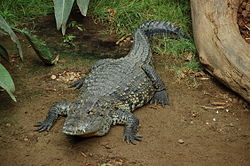
Morelet's crocodile (Crocodylus moreletii), also known as the Mexican crocodile or Belize crocodile, is a modest-sized crocodilian found only in the Atlantic regions of Mexico, Belize and Guatemala. It usually grows to about 3 metres (10 ft) in length. It is a species at least concern for extinction according to the International Union for Conservation of Nature.
The species has a fossil record in Guatemala. (Full article...) -
Image 15A smooth-fronted caiman at Zoologischer Garten Berlin in Berlin, Germany
The smooth-fronted caiman (Paleosuchus trigonatus), also known as Schneider's dwarf caiman or Schneider's smooth-fronted caiman, is a crocodilian from South America, where it is native to the Amazon and Orinoco Basins. It is the second-smallest species of the family Alligatoridae, the smallest being Cuvier's dwarf caiman, also from tropical South America and in the same genus. An adult typically grows to around 1.2 to 1.6 m (3.9 to 5.2 ft) in length and weighs between 9 and 20 kg (20 and 44 lb). Exceptionally large males can reach as much as 2.3 m (7.5 ft) in length and 36 kg (79 lb) in weight. (Full article...) -
Image 16Mato Grosso, Brazil
The yacare caiman (Caiman yacare), also known commonly as the jacare caiman, Paraguayan caiman, piranha caiman, red caiman, and southern spectacled caiman, is a species of caiman, a crocodilian in the family Alligatoridae. The species is endemic to Argentina, Bolivia, Brazil, and Paraguay. Brown in color and covered with dark blotches, males grow to a total length (including tail) of 2–3 m (6 ft 7 in – 9 ft 10 in) and weigh around 40–50 kg (88–110 lb); while females grow to 1.4 m (4 ft 7 in) long and about 15–20 kg (33–44 lb). Typical habitats of this caiman include lakes, rivers, and wetlands. Its diet primarily consists of aquatic animals, such as snails, and occasionally land vertebrates. Mating occurs in the rainy season and eggs hatch in March, with young fending for themselves as soon as they hatch. The yacare caiman was hunted heavily for its skin to use for leather in the 1980s, which caused its population to decrease significantly. However, trading restrictions placed since have caused its population to increase. Its population in the Pantanal is about 10 million, and it is listed as least concern on the IUCN Red List. (Full article...) -
Image 17

The black caiman (Melanosuchus niger) is a crocodilian reptile endemic to South America. With a maximum length of around 5 to 6.5 m (16 to 21 ft) and a mass of over 450 kg (1,000 lb), it is the largest living species of the family Alligatoridae, and the third-largest crocodilian in the Neotropical realm. True to its common and scientific names, the black caiman has a dark greenish-black coloration as an adult. In some individuals, the pigmentation can appear almost jet-black. It has grey to brown banding on the lower jaw; juveniles have a more vibrant coloration compared to adults, with prominent white-pale yellow banding on the flanks that remains present well into adulthood (more than most other species). The banding on young helps with camouflage by breaking up their body outline, on land or in water, in an effort to avoid predation. The morphology is quite different from other caimans but the bony ridge that occurs in other caimans is present. The head is large and heavy, an advantage in catching larger prey. Like all crocodilians, caimans are long, squat creatures, with big jaws, long tails and short legs. They have thick, scaled skin, and their eyes and noses are located on the tops of their heads. This enables them to see and breathe while the rest of their bodies are underwater.
A carnivorous animal, the black caiman lives along freshwater habitats, including slow-moving rivers, lakes and seasonally flooded savannas, where it preys upon a variety of fish, reptiles, birds, and mammals. Being an apex predator and potentially a keystone species, it is generalist, capable of taking most animals within its range, and might have played a critical role in maintaining the structure of the ecosystem. Although only a mere few specific ecological studies have been conducted, it is observed that this species has its own niche which allows coexistence with other competitors. (Full article...) -
Image 18At Le Bonheur Crocodile Farm near Stellenbosch, South Africa
The Nile crocodile (Crocodylus niloticus) is a large crocodilian native to freshwater habitats in Africa, where it is present in 26 countries. It is widely distributed in sub-Saharan Africa, occurring mostly in the eastern, southern, and central regions of the continent, and lives in different types of aquatic environments such as lakes, rivers, swamps and marshlands. It occasionally inhabits deltas, brackish lakes and rarely also saltwater. Its range once stretched from the Nile Delta throughout the Nile River. Lake Turkana in Kenya has one of the largest undisturbed Nile crocodile populations.
Generally, the adult male Nile crocodile is between 3.5 and 5 m (11 ft 6 in and 16 ft 5 in) in length and weighs 225 to 750 kg (496 to 1,653 lb). However, specimens exceeding 6.1 m (20 ft) in length and 1,000 kg (2,200 lb) in weight have been recorded. It is the largest predator in Africa, and may be considered the second-largest extant reptile in the world, after the saltwater crocodile (Crocodylus porosus). Size is sexually dimorphic, with females usually about 30% smaller than males. The crocodile has thick, scaly, heavily armoured skin. (Full article...) -
Image 19

The mugger crocodile (Crocodylus palustris) is a medium-sized broad-snouted crocodile, also known as mugger and marsh crocodile. It is native to freshwater habitats from south-eastern Iran to the Indian subcontinent, where it inhabits marshes, lakes, rivers and artificial ponds. It rarely reaches a body length of 5 m (16 ft 5 in) and is a powerful swimmer, but also walks on land in search of suitable waterbodies during the hot season. Both young and adult mugger crocodiles dig burrows to which they retreat when the ambient temperature drops below 5 °C (41 °F) or exceeds 38 °C (100 °F). Females dig holes in the sand as nesting sites and lay up to 46 eggs during the dry season. The sex of hatchlings depends on temperature during incubation. Both parents protect the young for up to one year. They feed on insects, and adults prey on fish, reptiles, birds and mammals.
The mugger crocodile evolved at least 4.19 million years ago and has been a symbol for the fructifying and destructive powers of the rivers since the Vedic period. It was first scientifically described in 1831 and is protected by law in Iran, India and Sri Lanka. Since 1982, it has been listed as Vulnerable on the IUCN Red List. Outside protected areas, it is threatened by conversion of natural habitats, gets entangled in fishing nets and is killed in human–wildlife conflict situations and in traffic accidents. (Full article...) -
Image 20At the Cincinnati Zoo
The Chinese alligator (Alligator sinensis; simplified Chinese: 鼍; traditional Chinese: 鼉; pinyin: tuó), also known as the Yangtze alligator (simplified Chinese: 扬子鳄; traditional Chinese: 揚子鱷; pinyin: yángzǐ'è), China alligator, or historically the muddy dragon, is a crocodilian endemic to China. It and the American alligator (A. mississippiensis) are the only living species in the genus Alligator of the family Alligatoridae. Dark gray or black in color with a fully armored body, the Chinese alligator grows to 1.5–2.1 metres (5–7 ft) in length and weighs 36–45 kilograms (80–100 lb) as an adult. It brumates in burrows in winter and is nocturnal in summer. Mating occurs in early summer, with females most commonly producing 20–30 eggs, which are smaller than those of any other crocodilian. The species is an opportunistic feeder, primarily eating fish and invertebrates. A vocal species, adults bellow during the mating season and young vocalize to communicate with their parents and other juveniles. Captive specimens have reached age 70, and wild specimens can live past 50.
Living in bodies of fresh water, the Chinese alligator's range is restricted to six regions in the province of Anhui, as well as possibly the provinces of Jiangsu and Zhejiang. Originally living as far away from its current range as Japan, the species previously had a wide range and population, but beginning in 6000 BC, multiple threats, such as habitat destruction, caused the species' population and range to decline. The population in the wild was about 1,000 in the 1970s, decreased to below 130 in 2001, and grew after 2003, with its population being about 300 as of 2017. Listed as critically endangered by the International Union for Conservation of Nature, multiple conservation actions have been taking place for this species. (Full article...) -
Image 21
The Orinoco crocodile (Crocodylus intermedius) is a critically endangered crocodile. Its population is very small, and they can only be found in the Orinoco river basin in Venezuela and Colombia. Extensively hunted for their skins in the 19th and 20th centuries, it is one of the most endangered species of crocodiles. It is a very large species of crocodilian; males have been reported up to 6.8 m (22 ft 4 in) in the past, weighing over 900 kg (2,000 lb), but such sizes do not exist today, 5.2 m (17 ft 1 in) being a more widely accepted maximum size. A large male today may attain 4.2 m (13 ft 9 in) in length and can weigh up to 450 kg (1,000 lb), while females are substantially smaller with the largest likely to weigh around 225 kg (496 lb). Sexual dimorphism is not as profound as in other crocodilian species. The coloration is light even in adults.
The ecology of the Orinoco crocodile is poorly documented in the wild, mostly due to its small population. It is thought to have a more piscivorous diet with an opportunistic nature, resulting in generalist predatory behaviour. It is an apex predator and preys on a variety of birds, mammals and reptiles, including caimans on occasion. Its prey base is mostly large predatory fish, challenging the general view by locals complaining about crocodiles hunting local fish to very low numbers. Reproduction takes place in the dry season when the water level is low. It is a hole nester and digs holes in the sand for its clutch of eggs. The females guard the nests and young for several years. (Full article...) -
Image 22
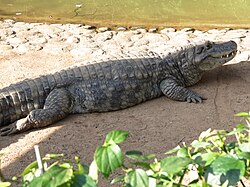
The broad-snouted caiman (Caiman latirostris) is a crocodilian in the family Alligatoridae found in eastern and central South America, including the Pantanal habitat of Bolivia, Southeast Brazil, and Paraguay, as well as northern Argentina and Uruguay. Behind the black caiman (Melanosuchus niger), it is the second-largest caiman species; it is the third-largest alligatorid behind the American alligator (Alligator mississippiensis) and the aforementioned black caiman. Primarily, the species inhabits freshwater wetlands, including floodplains, marshes, swamps, and some mangrove forests, as well as various streams, rivers, lakes or ponds, preferring bodies of rather still or slower-moving water. They will often utilize man-made cow ponds, disused stock tanks, and canals and ditches, as well. (Full article...) -
Image 23West African crocodile in Bazoulé, Burkina Faso
The West African crocodile, desert crocodile, or sacred crocodile (Crocodylus suchus) is a species of crocodile related to, and often confused with, the larger Nile crocodile (C. niloticus). (Full article...)
Selected snake articles
-
Image 1

Boiga beddomei, commonly known as Beddome's cat snake, is a species of rear-fanged snake in the family Colubridae. The species is endemic to the Western Ghats of India, in Maharashtra, Gujarat and Goa states. (Full article...) -
Image 2

Agkistrodon piscivorus is a species of venomous snake, a pit viper in the subfamily Crotalinae of the family Viperidae. It is one of the world's few semiaquatic vipers (along with the Florida cottonmouth), and is native to the Southeastern United States. As an adult, it is large and capable of delivering a painful and potentially fatal bite. When threatened, it may respond by coiling its body and displaying its fangs. Individuals may bite when feeling threatened or being handled in any way. It tends to be found in or near water, particularly in slow-moving and shallow lakes, streams, and marshes. It is a capable swimmer, and like several species of snakes, is known to occasionally enter bays and estuaries and swim between barrier islands and the mainland. (Full article...) -
Image 3
Taipans are snakes of the genus Oxyuranus in the elapid family. They are large, fast-moving, extremely venomous, and endemic to Australia and New Guinea. Three species are recognised, one of which, the coastal taipan, has two subspecies. Taipans are some of the deadliest known snakes. (Full article...) -
Image 4

Craspedocephalus borneensis, commonly known as the Bornean pit viper, is a venomous pit viper species endemic to the island of Borneo. No subspecies are currently recognized. (Full article...) -
Image 5Green tree python at Sydney Zoo
The green tree python (Morelia viridis), is a species of snake in the family Pythonidae. The species is native to New Guinea, some islands in Indonesia, and the Cape York Peninsula in Australia. First described by Hermann Schlegel in 1872, it was known for many years as Chondropython viridis. As its common name suggests, it is a bright green snake that can reach a total length (including tail) of 2 m (6.6 ft) and a weight of 1.6 kg (3.5 lb), with females slightly larger and heavier than males. Living generally in trees, the green tree python mainly hunts and eats small reptiles and mammals. It is a popular pet, and numbers in the wild have suffered with large-scale smuggling of wild-caught green tree pythons in Indonesia. Despite this, the green tree python is rated as least concern on the IUCN Red List of endangered species. (Full article...) -
Image 6
Salvadora is a genus of colubrid snakes commonly called patchnose snakes or patch-nosed snakes, which are endemic to the western United States and Mexico. They are characterized by having a distinctive scale on the tip of the snout. (Full article...) -
Image 7

The western diamondback rattlesnake or Texas diamond-back (Crotalus atrox) is a rattlesnake species and member of the viper family, found in the southwestern United States and Mexico. Like all other rattlesnakes and all other vipers, it is venomous. It is likely responsible for the majority of snakebite fatalities in northern Mexico and the greatest number of snakebites in the U.S. No subspecies are currently recognized. (Full article...) -
Image 8
The yellow-bellied sea snake (Hydrophis platurus) is an extremely venomous species of snake from the subfamily Hydrophiinae (the sea snakes) found in tropical oceanic waters around the world except for the Atlantic Ocean. For many years, it was placed in the monotypic genus Pelamis, but recent molecular evidence indicates it lies within the genus Hydrophis. (Full article...) -
Image 9

Tantilla hobartsmithi, commonly known as Smith's black-headed snake and the southwestern blackhead snake, is a species of small snake in the subfamily Colubrinae of the family Colubridae. The species is native to the southwestern United States and adjacent northern Mexico. (Full article...) -
Image 10
Trimeresurus macrops is a venomous pit viper species endemic to Southeast Asia. No subspecies are currently recognized. Common names include large-eyed pitviper, green pit viper, and Kramer's pit viper. (Full article...) -
Image 11
Rattlesnakes are venomous snakes that form the genera Crotalus and Sistrurus of the subfamily Crotalinae (the pit vipers). All rattlesnakes are vipers. Rattlesnakes are predators that live in a wide array of habitats, hunting small animals such as birds and rodents. (Full article...) -
Image 12

The Japanese keelback (Hebius vibakari), sometimes called the ringed snake or water snake, is a species of colubrid snake, which is endemic to Asia. It was first described in 1826 by Heinrich Boie as Tropidonotus vibakari. (Full article...) -
Image 13

Boiga ceylonensis (Sri Lanka cat snake) is a species of rear-fanged, mildly venomous, nocturnal, arboreal colubrid snake endemic to Sri Lanka. (Full article...) -
Image 14A red-bellied black snake in Lamington National Park, Queensland
The red-bellied black snake (Pseudechis porphyriacus) is a species of venomous snake in the family Elapidae, indigenous to Australia. Originally described by George Shaw in 1794 as a species new to science, it is one of eastern Australia's most commonly encountered snakes. Averaging around 1.25 m (4 ft 1 in) in length, it has glossy black upperparts, bright red or orange flanks, and a pink or dull red belly. It is not aggressive and generally retreats from human encounters, but will defend itself if provoked. Although its venom can cause significant illness, no deaths have been recorded from its bite, which is less venomous than other Australian elapid snakes. The venom contains neurotoxins, myotoxins, and coagulants and has haemolytic properties. Victims can also lose their sense of smell. (Full article...) -
Image 15
The monocled cobra (Naja kaouthia), also called monocellate cobra and Indian spitting cobra, is a venomous cobra species widespread across South and Southeast Asia. It is characterized by a distinctive circular or "monocle"-shaped marking on the hood, though the pattern can be highly variable or even absent in some individuals. It occupies a wide range of habitats, including forests, agricultural land, and areas near human settlements. It is responsible for a significant proportion of snakebite incidents and fatalities in its range, due to its potent neurotoxic venom and frequent proximity to human settlements. Some populations of the monocled cobra have the ability to spit venom with notable accuracy, though not all individuals exhibit this behavior. (Full article...) -
Image 16

Gloydius blomhoffii, commonly known as the mamushi, Japanese moccasin, Japanese pit viper, Qichun snake, Salmusa or Japanese mamushi, is a pit viper species found in Japan. It was once considered to have 4 subspecies, but it is now considered monotypic. (Full article...) -
Image 17

Atheris hispida is a viper species endemic to Central Africa. Like all other vipers, it is venomous. It is known for its extremely keeled dorsal scales ("spikes") that give it a bristly appearance. No subspecies are currently recognized. Common names include rough-scaled bush viper, spiny bush viper, hairy bush viper, and others. (Full article...) -
Image 18Indian egg-eater at Amravati
The Indian egg-eating snake or Indian egg-eater (Boiga westermanni) is a rare species of egg-eating snake in the family Colubridae. The species is endemic to the Indian subcontinent. It is also called Westermann's snake, reflecting its scientific name. (Full article...) -
Image 19
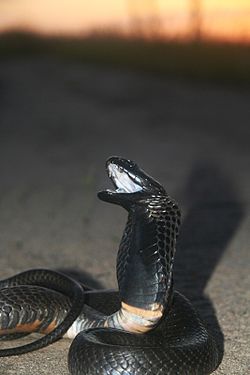
The black-necked spitting cobra (Naja nigricollis) is a species of spitting cobra found mostly in sub-Saharan Africa. They are moderately sized snakes that can grow to a length of 1.2 to 2.2 m (3.9 to 7.2 ft) in length. Their coloration and markings can vary considerably. They prey primarily on small rodents. They possess medically significant venom, although the mortality rate for untreated bites on humans is relatively low (~ 5–10%, in endemic regions under 1%). Like other spitting cobras, they can eject venom from their fangs when threatened (one drop over 7 metres (23 ft) and more in perfect accuracy). The cytotoxic venom irritates the skin, causing blisters and inflammation, and can cause permanent blindness if the venom makes contact with the eyes and is not washed off. (Full article...) -
Image 20

The pygmy python (Antaresia perthensis), also known as the anthill python, is a species of snake found in Western Australia. Their common names are due to their being the smallest member of the family Pythonidae and often being found in termite mounds. No subspecies are currently recognised. (Full article...) -
Image 21
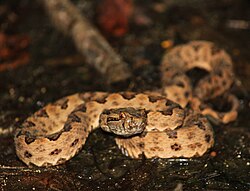
Protobothrops elegans is a pit viper species endemic to Japan in the southern Ryukyu Islands. No subspecies are currently recognized. Common names include: elegant pit viper, Sakishima habu (サキシマハブ), and elegant tree viper. (Full article...) -
Image 22
Anomochilidae is a family of snakes with one genus, Anomochilus, containing three species of snake. Members of the genus are known as anomochilids, or by the common names dwarf pipesnakes, lesser pipesnakes, and giant blind snakes. Initially created as Anomalochilus in 1890 for the species A. weberi, the genus was renamed in 1901 because the original name was already in use for a genus of beetles. Dwarf pipesnakes are small and cylindrical, with short, conical tails and small, rounded heads that are continuous with the neck. They have blackish to purplish-brown uppersides and dark brown or black undersides, with orange-red bands around the tail and a variety of pale markings on the snout and belly. All three species of dwarf pipesnake are endemic to Sundaland, where they are found on the Malay Peninsula and the islands of Sumatra and Borneo. (Full article...) -
Image 23

The California kingsnake (Lampropeltis californiae) is a nonvenomous colubrid snake endemic to the western United States and northern Mexico, and is found in a variety of habitats. Due to ease of care and a wide range of color variations, the California kingsnake is one of the most popular snakes in captivity. (Full article...) -
Image 24

The spotted python, eastern small-blotched python, or eastern Children's python (Antaresia maculosa) is a python species found in northern Australia and New Guinea. It is a popular pet among Australian reptile enthusiasts and other reptile enthusiasts abroad due to its small size and even temperament. No subspecies were originally recognized. However, two subspecies were recognized as of 2020; A. m. maculosa and A. m. peninsularis. (Full article...) -
Image 25
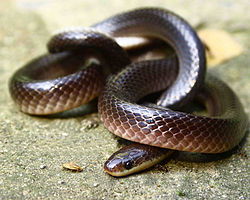
The lesser black krait (Bungarus lividus) is a species of venomous elapid snake found in India, Bangladesh, and Nepal.
The specific epithet is after Latin lividus, meaning “bluish metal-colored” or “lead-colored”, referring to the snake's coloration. (Full article...)
Selected lizard articles
-
Image 1
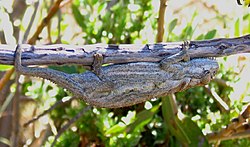
The Swartberg dwarf chameleon (Bradypodion atromontanum) is a species of chameleon endemic to South Africa. (Full article...) -
Image 2

The leopard gecko or common leopard gecko (Eublepharis macularius) is a ground-dwelling gecko native to the rocky dry grassland and desert regions of Afghanistan, Iran, Pakistan, India, and Nepal. The leopard gecko is a popular pet, and due to extensive captive breeding it is sometimes referred to as the first domesticated species of lizard. (Full article...) -
Image 3
The Transkei dwarf chameleon or Pondo dwarf chameleon (Bradypodion caffer) is a chameleon endemic to the Eastern Cape Province of South Africa. (Full article...) -
Image 4

Lepidodactylus lugubris, known as the mourning gecko or common smooth-scaled gecko, is a species of lizard, a gecko of the family Gekkonidae. (Full article...) -
Image 5

The Ngome dwarf chameleon (Bradypodion ngomeense) is a species of chameleon found in South Africa. (Full article...) -
Image 6

The northern Bahamian rock iguana (Cyclura cychlura) is a species of lizard of the genus Cyclura that is found on Andros Island and the Exuma islands in the Bahamas. Its status on the IUCN Red List is vulnerable, with a wild population of less than 5,000 animals. (Full article...) -
Image 7

The black rough-necked monitor (Varanus rudicollis) is a species of monitor lizard found in Southeast Asian countries of Thailand, Burma, and Malaysia. It is also found in Indonesia on Sumatra and islands of the Riau Archipelago It is sometimes known simply as the roughneck monitor. In Thailand is called h̄èā cĥāng (Thai: เห่าช้าง; "elephant bark/roar"). (Full article...) -
Image 8A Lesser Antillean iguana in Coulibistrie, Dominica
The Lesser Antillean iguana (Iguana delicatissima) is a large arboreal lizard endemic to the Lesser Antilles. It is one of two species of lizard of the genus Iguana and is in severe decline due to habitat destruction, introduced feral predators, hunting, and hybridization with its introduced sister species, the green iguana (Iguana iguana). Successful captive breeding of this species has been limited to only two instances, as most captive-laid eggs tend to be infertile. (Full article...) -
Image 9
The gold dust day gecko (Phelsuma laticauda) is a diurnal species of gecko. It lives in northern Madagascar, the Comoro Islands, and the Mascarene Islands; it has also been introduced to Hawaii and other Pacific islands. It is primarily an arboreal species which can be found in tropical forests and may also associate with human dwellings. The gold dust day gecko feeds on insects and nectar. (Full article...) -
Image 10

The smooth helmeted iguana (Corytophanes cristatus), also known as the helmeted iguana, the helmeted basilisk, the elegant helmeted lizard, and several other common names, is a species of Basilisk and a New World lizard in the family Corytophanidae. The species is native to southern Mexico, Central America, and northwestern South America. (Full article...) -
Image 11

The Namaqua dwarf chameleon or the western dwarf chameleon (Bradypodion occidentale) occurs in beach vegetation, along the west coast of South Africa and Namibia. (Full article...) -
Image 12

Gehyra mutilata, also known commonly as the common four-clawed gecko, Pacific gecko, stump-toed gecko, sugar gecko in Indonesia, tender-skinned house gecko, and butiki in Filipino, is a species of lizard in the family Gekkonidae. The species is native to Southeast Asia. It has made its way to several areas of the world including Sri Lanka, Indochina, and many of the Pacific Islands. Compared to the common house gecko (Hemidactylus frenatus), the appearance of G. mutilata is somewhat plump, with delicate skin. The skin is usually colored a soft purplish/pinkish gray, with golden spots on younger specimens; these spots eventually fade with age. (Full article...) -
Image 13

Draco melanopogon, commonly known as the black-bearded gliding lizard or black-barbed flying dragon, is a species of agamid "flying lizard" endemic to Southeast Asia. It is a typically forest-dwelling arboreal lizard. It preys on small invertebrates like ants and is oviparous. They are notable for relying solely on dewlap-mediated communication, instead of conveying signals via both headbobbing and employing dewlaps, as is typical for lizards with dewlaps. (Full article...) -
Image 14

Rhacodactylus leachianus, commonly known as the New Caledonian giant gecko, Leach's giant gecko, leachianus gecko, or Leachie, is the largest living species of gecko and a member of the family Diplodactylidae. It is native to most of New Caledonia. (Full article...) -
Image 15

The Drakensberg dwarf chameleon (Bradypodion dracomontanum) occurs in the Drakensberg, South Africa, between the latitudes of 27°45′ and 29°15′. Bright green dwarf chameleons (emerald dwarf chameleon) found in the Drakensberg south of 29°15′ are now known to be more closely related to the Natal Midlands dwarf chameleon (Bradypodion thamnobates) and may yet be described as a separate species. (Full article...) -
Image 16
The Cape dwarf chameleon (Bradypodion pumilum) is a chameleon native to the South African province of the Western Cape, where it is restricted to the region around Cape Town. (Full article...) -
Image 17
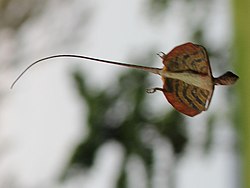
Draco taeniopterus, the Thai flying dragon, barred flying dragon, or barred gliding lizard, is a species of agamid lizard. It is found in Myanmar, Thailand, Cambodia, and Malaysia. (Full article...) -
Image 18The short-limbed bend-toed gecko (Mediodactylus brachykolon) is a species of gecko. The gecko is distinguished from others due to its distinctly short limbs, stout body and large head. In appearance it is similar to Altiphylax stoliczkai and Altiphylax baturensis.
The name of the gecko comes from Greek brachys meaning short and kolon meaning limb. (Full article...) -
Image 19

The Galápagos land iguana (Conolophus subcristatus) is a very large species of lizard in the family Iguanidae, and one of three species of the genus Conolophus. It is endemic to the Galápagos Islands off of Ecuador's Pacific coast, inhabiting the dry lowlands of Fernandina, Isabela, Santa Cruz, North Seymour, Baltra, and South Plaza islands. (Full article...) -
Image 20
Draco sumatranus, the common gliding lizard, is a species of agamid lizard endemic to Southeast Asia. It has elongated ribs and skin flaps on the sides of its body. When opened, these skin flaps allow it to glide between tree trunks. (Full article...) -
Image 21
Draco dussumieri, also known commonly as the Indian flying lizard, the southern flying lizard, and the Western Ghats flying lizard, is a species of lizard in the family Agamidae. The species is capable of gliding from tree to tree. It is found principally in the Western Ghats and some other hill forests of Southern India. It is almost completely arboreal, found on trees in forests and adjoining palm plantations where it climbs trees to forage for insects and glides to adjoining trees by expanding the patagium, loose skin on the sides of the body which is supported by elongated ribs to act as wings. The skin on the sides of the neck is also extended to the sides using the hyoid bones of the tongue as support. During the breeding season males maintain small territories which they defend from other males while courting females. The male has a more colourful patagium than the female, and it prominently extends its yellow dewlap forward in display. Although living almost its entire life in trees, the female descends to the ground to lay eggs in soil. This is the species with the westernmost distribution within the genus Draco, the majority of species occurring in Southeast Asia. (Full article...) -
Image 22White-throated monitor at Mountain Zebra National Park, South Africa
The rock monitor (Varanus albigularis) is a species of monitor lizard in the family Varanidae. The species is endemic to Sub-Saharan Africa, where, on average, it is the largest lizard found on the continent. It is called leguaan or likkewaan in some areas. (Full article...) -
Image 23
Varanus spinulosus, the Solomon Island spiny monitor, Isabel monitor, or spiny-neck monitor, is a species of monitor lizard. It is endemic to the Solomon Islands archipelago and is also known from Santa Isabel Island, San Jorge Island (Solomon Islands) and Bourgainville Island (Papua New Guinea). (Full article...) -
Image 24Orange iguana may refer to (Full article...)
-
Image 25Mediterranean house gecko in Rhodes, Greece
The Mediterranean house gecko (Hemidactylus turcicus) is a species of house gecko native to the Mediterranean region, from which it has spread to many parts of the world including parts of East Africa, South America, the Caribbean, and the Southern and Southeastern United States. It is commonly referred to as the Turkish gecko as represented in its Latin name and also as the moon lizard because it tends to emerge in the evening. (Full article...)
Selected turtle articles
-
Image 1
The red-necked pond turtle (Mauremys nigricans) is a species of turtles in the family Geoemydidae endemic to China. It is most likely restricted to Guangxi and Guangdong provinces, although pre-historic skull remains have been found in northern Vietnam and Hainan. Other common names include Kwangtung river turtle and black-necked pond turtle. (Full article...) -
Image 2
The hawksbill sea turtle (Eretmochelys imbricata) is a critically endangered sea turtle belonging to the family Cheloniidae. It is the only extant species in the genus Eretmochelys. The species has a global distribution that is largely limited to tropical and subtropical marine and estuary ecosystems. (Full article...) -
Image 3
The striped mud turtle (Kinosternon baurii) is a species of turtle in the family Kinosternidae. The species is native to the southeastern United States. (Full article...) -
Image 4
The furrowed wood turtle (Rhinoclemmys areolata) is a species of turtle belonging to the genus Rhinoclemmys of the family Geoemydidae found in the Yucatán Peninsula and adjacent regions of Central America. (Full article...) -
Image 5
The saw-shelled turtle (Myuchelys latisternum) is a species of turtle in the Chelidae family endemic to Australia, ranging along rivers and streams and connected swamps and lagoons from coastal Cape York Peninsula to northern New South Wales, with populations also noted as far south as Newcastle - (Williams River Catchment site of the former Tilligra Dam). They are thought to have been introduced to Lake Eacham in the Atherton Tablelands. Other common English names are: serrated snapping turtle or common sawshell turtle. (Full article...) -
Image 6

Adanson's mud turtle (Pelusios adansonii) is a species of turtle in the family Pelomedusidae. The species is endemic to north-central Africa. (Full article...) -
Image 7Pond turtle may refer to:
- Emydidae, a family of pond turtles
- Emys, a genus of Emydidae
- European pond turtle (Emys orbicularis)
- Sicilian pond turtle (Emys trinacris)
- Western pond turtle (Actinemys marmorata or Emys marmorata)
- Emys, a genus of Emydidae
- Giant Asian pond turtle (Heosemys grandis)
- Mauremys, a genus of pond turtles
- Chinese pond turtle (Mauremys reevesii)
- Japanese pond turtle (Mauremys japonica)
- Philippine forest turtle or Leyte pond turtle (Heosemys leytensis)
- Emydidae, a family of pond turtles
-
Image 8

The red side-necked turtle (Rhinemys rufipes), red turtle, red-footed sideneck turtle, William's toadhead turtle, or red-footed Amazon side-necked turtle is a monotypic species of turtle in the family Chelidae. It is found in Brazil, Colombia, and possibly Peru. (Full article...) -
Image 9The Upemba mud turtle (Pelusios upembae) is a species of turtle in the family Pelomedusidae. (Full article...)
-
Image 10
The big-headed turtle (Platysternon megacephalum) is a species of turtle in the family Platysternidae from Southeast Asia and southern China. (Full article...) -
Image 11Red-bellied short-necked turtle at Cologne Zoo
The red-bellied short-necked turtle (Emydura subglobosa), also known commonly as the pink-bellied side-necked turtle and the Jardine River turtle, is a species of turtle in the family Chelidae. The species is native to Australia and New Guinea. There are two recognized subspecies. (Full article...) -
Image 12
The Indian roofed turtle (Pangshura tecta) is a species of turtle in the family Geoemydidae. It can be distinguished by the distinct "roof" at the topmost part of the shell. It is found in the major rivers of South Asia. It is a common pet in the Indian Subcontinent. (Full article...) -
Image 13
The African helmeted turtle (Pelomedusa subrufa), also known commonly as the marsh terrapin, the crocodile turtle, or in the pet trade as the African side-necked turtle, is a species of omnivorous side-necked terrapin in the family Pelomedusidae. The species naturally occurs in fresh and stagnant water bodies throughout much of Sub-Saharan Africa, and in southern Yemen. (Full article...) -
Image 14Babai River, Nepal
The Indian softshell turtle (Nilssonia gangetica), or Ganges softshell turtle, is a species of softshell turtle found in South Asia in rivers such as the Ganges, Indus and Mahanadi. This vulnerable turtle reaches a carapace length of up to 94 cm (37 in). It feeds mostly on fish, amphibians, carrion and other animal matter, but also takes aquatic plants. This turtle is listed in part II of Schedule I of the Wild Life (Protection) Act, 1972 and possession of this species is an offence. (Full article...) -
Image 15

The Central American snapping turtle (Chelydra rossignonii), also known commonly as the Mexican snapping turtle and the Yucatán snapping turtle, is a species of turtle in the family Chelydridae. The species is endemic to Central America and Mexico. (Full article...) -
Image 16seen in Sonora, Mexico
The northern spotted box turtle (Terrapene nelsoni klauberi), also commonly known as Klauber's box turtle and Klauber's spotted box turtle, is a subspecies of turtle in the family Emydidae. (Full article...) -
Image 17
The Amboina box turtle or Southeast Asian box turtle (Cuora amboinensis) is a species of Asian box turtle widely distributed across Southeast Asia. It is native to the Asian mainland from northeast India, through Bangladesh, Burma and Thailand, across Laos, Cambodia, Vietnam, and Malaysia. It is also found on the archipelagos of Indonesia and the Philippines. (Full article...) -
Image 18Red-cheeked mud turtle (K. s. cruentatum), in Quintana Roo, Mexico
The scorpion mud turtle or Tabasco mud turtle (Kinosternon scorpioides) is a species of mud turtle in the family Kinosternidae. It is found in Mexico, Central and South America. (Full article...) -
Image 19
The brown wood turtle or brown land turtle (Rhinoclemmys annulata) is a species of turtle in the family Geoemydidae. The species is endemic to Central America and northern South America. (Full article...) -
Image 20
The yellow-headed temple turtle (Heosemys annandalii) is a large species of turtle in the family Geoemydidae. The species is native to Southeast Asia. (Full article...) -
Image 21The Hunan softshell turtle (Pelodiscus axenaria) is a species of turtle in the family Trionychidae, the softshells. It is endemic to China, where it occurs in Hunan, Guangdong, Guangxi, and Jiangxi provinces. It is found in Taoyuan, Pingjiang, Rucheng, Lingling, and Shaoyang counties of Hunan province (Zhou, Zhang & Fang, 1991). (Full article...)
-
Image 22

The red-headed Amazon side-necked turtle, red-headed river turtle or red-headed sideneck (Podocnemis erythrocephala) is a species of turtle in the family Podocnemididae. It is found in the Amazon basin in Brazil, Colombia, and Venezuela. (Full article...) -
Image 23

Bourret's box turtle (Cuora bourreti), also known commonly as the central Vietnamese flowerback box turtle and the Indochinese box turtle, is a species of turtle in the family Geoemydidae. The species is endemic to Southeast Asia. (Full article...) -
Image 24
Stone turtle on a fence post, a design in a park in Kunyang, Yunnan
Post turtle is a phrase that has been used in political discourse of various countries based on an old joke about the leader of a group being comparable to a turtle balanced on top of a fence post. (Full article...) -
Image 25

The black softshell turtle or Bostami turtle (Nilssonia nigricans), previously placed in genus Aspideretes, is a species of freshwater turtle found in India (Assam and Tripura) and Bangladesh (Chittagong and Sylhet). It was long believed to consist of inbred individuals of the Indian softshell turtle (A. gangeticus or N. gangeticus) or the Indian peacock softshell turtle (A. hurum or N. hurum), but while it is a close relative of the latter, it is a distinct species. (Full article...)
Need help?
Do you have a question about Reptiles that you can't find the answer to?
Consider asking it at the Wikipedia reference desk.
Topics
Major extant reptile clades | |||||
|---|---|---|---|---|---|
| Lepidosauria | |||||
| Archelosauria |
| ||||
Related portals
Associated Wikimedia
The following Wikimedia Foundation sister projects provide more on this subject:
-
Commons
Free media repository -
Wikibooks
Free textbooks and manuals -
Wikidata
Free knowledge base -
Wikinews
Free-content news -
Wikiquote
Collection of quotations -
Wikisource
Free-content library -
Wikiversity
Free learning tools -
Wiktionary
Dictionary and thesaurus





